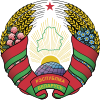User:Rudjek/Portal:Belarus/Intro
 |
 |

| |
The Republic of Belarus is a landlocked nation-state in Eastern Europe, which borders Latvia, Lithuania, Poland, Russia and Ukraine. Its capital city is Minsk, and other important cities include Brest, Grodno (Hrodna), Gomel (Homyel'), Mahilyow and Vitebsk (Viciebsk).
Throughout much of history, the area which is now known as Belarus was part of various countries including Grand Duchy of Lithuania, Poland and the Russian Empire. Eventually, in 1922, Belarus became a republic in the Soviet Union as the Byelorussian SSR. The republic officially declared its sovereignty on 27 August 1990, and following the collapse of the Soviet Union, declared independence as the Republic of Belarus on 25 August 1991. Since 1994, amidst allegations of human rights violations and autocracy, Alexander Lukashenko has been the nation's president. As a consequence, Belarus has been excluded from joining the Council of Europe. The country also continues to suffer from the effects of nuclear fallout from the 1986 Chernobyl accident, which took place in neighboring Ukraine. Belarus is also in negotiations with neighboring Russia to integrate both of their economies, among other things, in a plan called the Union of Russia and Belarus.
Officially, the country is known as the Republic of Belarus (Belarusian: Рэспубліка Беларусь, Łacinka: Respublika Biełaruś; Russian: Республика Беларусь, Respublika Belarus), while the short name is Belarus (Беларусь, Biełaruś, Беларусь). The earlier name "Belorussia" (Белоруссия) can still be found in use, although mainly in historical contexts. Some consider the use of "Belorussian" derogatory, with its direct implication of Russification. The name has incorrectly been translated as "White Russia", a name that refers to a separate region.
